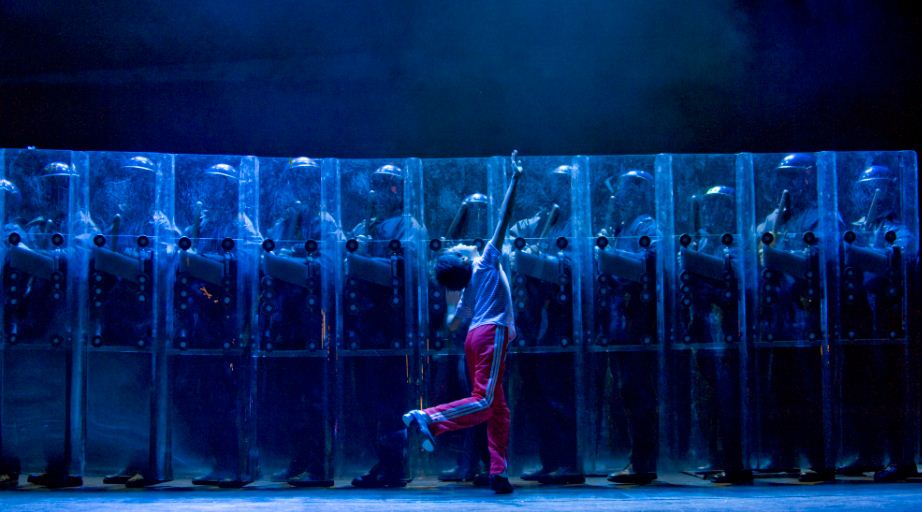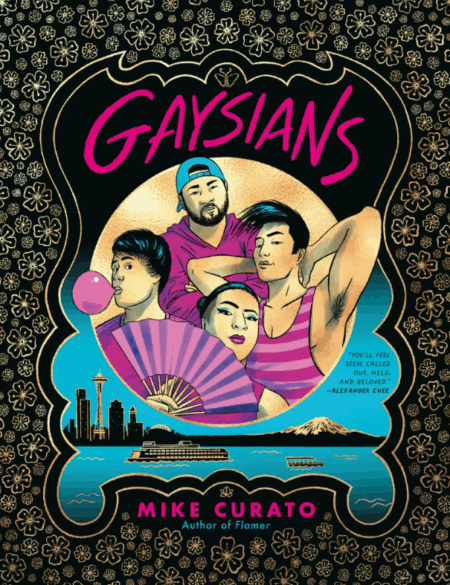Review: Billy Elliot The Musical. Book and Lyrics by Lee Hall. Music by Elton John. Choreographed by Peter Darling. Directed by Stephen Daldry. Based on the film and original screenplay by Lee Hall. With Faith Prince, Rich Hebert, Patti Perkins, Jeff Kready, Griffin Birney and Lex Ishimoto as Billy Elliot. Now through April 3 at The Paramount.

The explosive end of Act One of "Billy Elliot The Musical" now playing at The Paramount through April 3: : Billy (Lex Ishimoto) does the "Angry Dance". Photo: Michael Brosilow
The Billy Elliot success story is well known. Small British film about an 11 year old British boy who yearns to be a ballet dancer against the objections of his working class family set against the very much real coal miner’s strike of 1984 became a huge international hit in 2000, winning film awards and the hearts of millions of film fans, including Elton John. Strongly identifying with the story, (artistic boy seeks approval from working class dad) John and his partner David Furnish approached director Stephen Daldry at an early screening of the film at the Cannes Film Festival and blurted, “I want to turn this into a musical!” Fast forward to 2005 and “Billy Elliot The Musical” takes the West End of London by storm winning a slew of Olivier awards which in turn was repeated with the Australian premiere in 2007, and the American premiere in 2008 where the musical won 10 Tony Awards and was proclaimed “Musical of the Decade!” by Time magazine. Billy Elliot is apparently, “now and forever” with the show still running in London, NYC, Toronto and now in Seattle at The Paramount, on its first national tour. It’s entered the canon of great theatrical musicals.
But, is it warranted?
Yes, it is. Like the film, Billy Elliot The Musical has both enormous heart and deep pathos. It offers a cutting look at Margaret Thatcher’s England and the class divisions in British society. It features some charming comedy as well as heartfelt emotion. At the heart of the piece, though, is the brilliant dancing of an 11 year old boy with a big talent and huge aspirations. The show soars to emotional high peaks when we see Billy do what he does best: dance.
But, we also come crashing down to earth from time to time. I’ve kvetched in many a column about my disdain for the current theatrical trend of turning movies into musicals. (Ideal comparison: It’s like trying to turn a carrot into a steak…they’re two entirely different things. Yes, you eat both of them but structurally they are not really comparable.) What works in film doesn’t necessarily translate well into a stage piece. And, musical creators are hampered with the demands of the fans of the original work. They dare not CHANGE or omit too much of anything from the original, no matter how inorganic it might be to the structure of the staged drama. The result is moments when the flow of the musical seems stunted and false with characters and situations that don’t work in the context of the stage.
Here’s an example: In both the film and musical, Billy lives with his widowed father, his much older brother, also a coal miner, and his senile grandmother. Grandma is strictly comedy relief in the musical; she serves no purpose other than to be cute. She inexplicably gets a big number but it doesn’t SERVE the story; it just stops the show for a moment so the actress playing the part has something to do. Meanwhile, the angry older brother, who does serve an important role, gets little to do in the first act of the musical and emerges in the second act as important, yet oddly he never gets his own number. It’s clunky theater and it hurts the musical stage story.
Want another example? Mrs. Wilkinson, the snappy dance teacher is a big, juicy important role in both film and musical. She was brilliantly played by Julie Walters in the film, and she’s a vital SUPPORTING character who plays a big role but disappears for much of the film, which works in the context and language of cinema. You love the character and you might miss her, but the structure and narrative of film allows for that character to step back, (if the film is well written and directed). But, that doesn’t work in the construction of musical theater. Billy Elliot, the boy, is the star of Billy Elliot The Musical and that’s fine, but the narrative demands of theater need their characters to behave and perform in different ways. A female leading role in a stage musical, even a character role, requires a certain growth and expectation. Mrs. Wilkinson onstage, (and very ably played by Broadway veteran actress Faith Prince) dominates the first act, and largely disappears for the second. The character of the father takes over for the second half of the show and because that character isn’t as interesting as Mrs. Wilkinson, the show suffers. Yes, that was the plot of the film, and it works fine in that medium, but on stage it makes for poor theater. You keep hoping, Dad will drop dead and the fun lady will swoop in to take things over, but it never happens. (And, let me note that Rich Hebert as Billy’s dad is fine in the role. It’s not the actor’s fault that his character isn’t as interesting as Mrs. Wilkinson!) If Billy Elliot: The Musical was being created in 1958 by Jule Styne and George Abbott and they had this problem adapting a film to stage, they would have simply done the sensible thing: made Mrs. Wilkinson the co-star to Billy and had HER take Billy to London. But, musical theater creators today can’t do that…or, at least think they can’t tamper that much with the original lest the fans howl. It’s a mistake on their part. They need to stop slavishly revering cinema and remember to make good THEATER.
I’m done kvetching about the folly of adapting film to stage. Billy Elliot The Musical does have its lumpen moments, and it takes awhile to get going, but when the show works, it can do some amazing things, most of which can be attributed to Stephen Daldry’s frequently brilliant direction and the choreography of Peter Darling. The two men have collaborated on achieving the impossible of making staged action/dance sequences seem like edited sequences of film with character movements and actions choreographed with the music that manage to advance the story through time and place with a vivid pace and cinematic energy. Early in Act One the number “Solidarity” combines the striking miners clashing with the massive police force sent by Margaret Thatcher and entwining it with the story and motions of a child’s ballet class. The images of the violence of the men and their passion and anger interacting with the innocence and charm of children was powerful and commanding. There are times when this musical feels more like a modern dance piece than a traditional form of musical theater and that is all due to the artistry of Mr. Daldry and Mr. Darling. Their work shines again in the first act closing number, simply titled “Angry Dance” when Billy Elliot releases his frustrations through dance, with the backdrop of the riot gear equipped police advancing menacingly on the boy. It was a brilliant piece of dance staging and choreography and astonishingly performed by last night’s Billy, Lex Ishimoto. That scene alone was worth the price of admission.
As for Mr. Ishimoto, who alternates in the very demanding role with three other actors, the young actor did a brilliant job with the dance aspects of the role and made an appealing actor and a passable singer which works fine in the context of the show. The part requires that a professional dancer play this role and how many professional 11 or 12 year old boy dancers do you know who can sing and act? (If you do, send them to www.BeBilly.com. Yes, it’s a real site…the sad fact of the matter is, the tiny number of kids with the talent to play this role, quickly age out of it. Billy can’t have a deep voice or hairy legs!)
The rest of the cast did an excellent job with the big stand out for me, being Griffin Birney as Billy’s cross-dressing, Baby Gay to be friend Michael. Mr. Birney is a Broadway kid who can do it all; sing, act and dance and he won the audience over with his big number “Expressing Yourself”. (Note to directors/choreographers of future productions of “Billy”: Drop the stupid dancing dresses from the number. It doesn’t need them. The talent of the kids is plenty. Leave that kind of kitsch to Disney.)
Technically and from a design point, the show was very well done though the sound at times was a bit muddy which could also be partly attributed to the North Country accents used, which can be hard to understand.
Do I recommend Billy Elliot The Musical? Yes, with a couple of reservations, but the heart of this show is in the dancing and it is in those moments that both the character and the musical get to soar.










No Way! Your changes to the show would ruin it by destroying the comedy relief necessary to convey it depressing message. Dancing dresses, grandma, the boxing coach, the Chrismas celebration and the ballet girls are perfect because they break the flow of a too “deep” plot